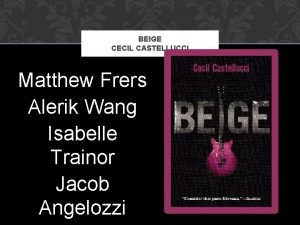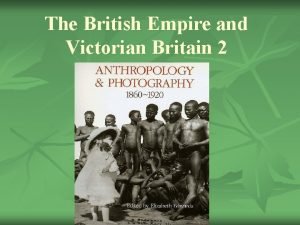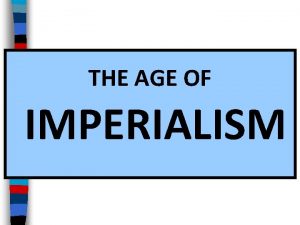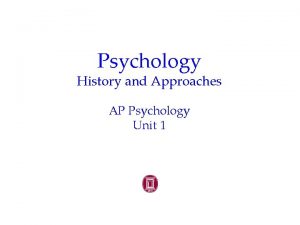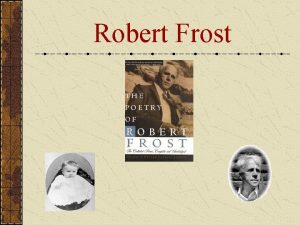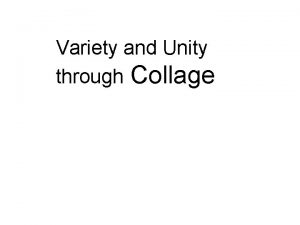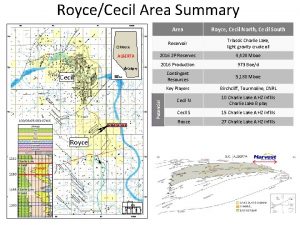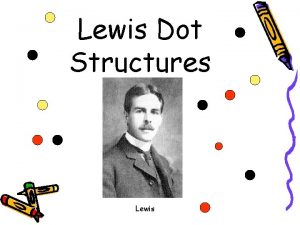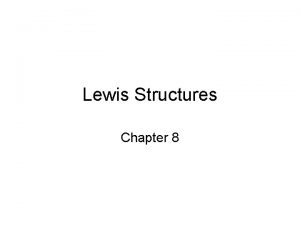A Hard Frost Cecil Day Lewis A Hard












- Slides: 12

A Hard Frost Cecil Day Lewis

A Hard Frost A frost came in the night and stole my world And left this changeling for it - a precocious Image of spring, too brilliant to be true: White lilac on the window-pane, each grass-blade Furred like a catkin, maydrift loading the hedge. The elms behind the house are elms no longer But blossomers in crystal, stems of the mist That hangs yet in the valley below, amorphous As the blind tissue whence creation formed.

The sun looks out and the fields blaze with diamonds Mockery spring, to lend this bridal gear For a few hours to a raw country maid, Then leave her all disconsolate with old fairings Of aconite and snowdrop! No, not here Amid this flounce and filigree of death Is the real transformation scene in progress, But deep below where frost Worrying the stiff clods unclenches their Grip on the seed and lets the future breathe.

Cecil Day-Lewis: ▪ Born 27 April 1904, died on 22 May 1972. ▪ He was an Anglo-Irish poet and the Poet Laureate of the United Kingdom from 1968 until his death in 1972. ▪ Day-Lewis was born in Ballintubbert, Ireland. ▪ He was the son of Frank Day-Lewis and Kathleen ▪ After the death of his mother in 1906, Cecil was brought up in London by his father. ▪ He was educated at Sherborne School and at Wadham College, Oxford. In Oxford.

Cecil Day-Lewis: ▪ In 1928 he married Constance Mary King, the daughter of a Sherborne master (i. e. teacher), and worked as a schoolmaster. ▪ During the 1940 s he had a long and troubled love affair with the novelist Rosamond Lehmann. ▪ His first marriage was dissolved in 1951, and he married actress Jill Balcon. ▪ Cecil Day-Lewis died from pancreatic cancer on 22 May 1972, aged 68, at Lemmons.

Summary: ▪ This poem is describing the beautiful scene the poet saw one day he woke up in winter morning. ▪ The most prominent imagery used is the frost and snow, likening them to brilliant white diamonds, which shine and reflect in the sunlight. ▪ These are used to portray a beautiful scene of white snow spreading all over the forest. ▪ Usually the forest in Winter gave people a sense of cruelty, harshness and lifeless, but after having a white frost coating on the dead trees, mountains, everything seemed to become glamorous and attractive ▪ Besides portraying the stunning scenery, the poet also wanted to relate the transformation in nature to human life cycle which lies beneath the cold and snow.

A baby that is secretly left to replace another baby. In this case the day is sunny and bright and looks like it may be spring. A thin layer of ice that forms when the air becomes cold. The image of the thief in the night who takes whilst the occupants are sleeping. His “world” has been transformed or “stolen” by the frost and is no longer the same. A frost came in the night and stole my world A child that has certain attributes of an adult And left this changeling for it - a precocious at a very early age Image of spring, too brilliant to be true: White lilac on the window-pane, each grass-blade Furred like a catkin, maydrift loading the hedge. The white is unreal and the frost on the window The elms behind the house are elms no longer panes creates patterns. But blossomers in crystal, stems of the mist That hangs yet in the valley below, amorphous As the blind tissue whence creation formed. The mists and swamps of primordial ooze from which life is said to have emerged. Having no form or shape, like the mist.

The reflection of the sun on the ice looks like a field of sparkling diamonds The sun and fields mock spring because nothing grows in winter. A poisonous root A white flower Though the changes are noticeable above the ground the real changes are happening below. The sun looks out and the fields blaze with diamonds The frost is “new Mockery spring, to lend this bridal gear clothing” for the For a few hours to a raw country maid, fields and it makes Then leave her all disconsolate with old fairings the plain country look like a newly adorned Of aconite and snowdrop! No, not here bride for a while until Amid this flounce and filigree of death it melts. Is the real transformation scene in progress, But deep below where frost Exaggerated Worrying the stiff clods unclenches their and ornamental. Grip on the seed and lets More for show than of real the future breathe. substance

Analysis: ▪ This poem deals with the change that is seen in the morning after the frost has settled overnight: – The poet highlights the beauty and the purity of the scene and through a series of comparisons paints an evocative picture of the landscape. – Much of the language used in these comparisons is archaic or unfamiliar, so use of the note and a dictionary is vital to understand those unfamiliar descriptions. ▪ The first stanza ends with a description of the mist enshrouding a valley. The poet alludes to the primordial mists that covered the earth in the creation.

Analysis: ▪ This introduces one of the major themes underpinning the poem, that of the transformation and rebirth that is part of the cyclical process of nature. ▪ This is further developed in the last lines of the poem where the poet states that though the weather is bleak and harsh under the ground the seeds of summer are already preparing for their new lives. ▪ In the middle of stanza two the poet likens the scenery in purity and beauty to a bride adorned for her wedding, however he is quick to point out that this is a fleeting transformation and the “bride” will soon return to ”a raw country maid” with the melting of the frost by the sun.

Analysis: ▪ He ends the poem by saying that all the beauty and ornamentation of the ice, frost and snow is really meaningless. ▪ This is because the real “work” of regeneration and procreation is happening under the frost and soil in the ground as the seedlings prepare for the summer.

Questions: 1. What is the tone of this poem? Give quotes to support your answer? (3) 2. What is the poet’s feelings towards the morning frost? Explain your answer. (4) 3. Discuss the imagery in the first stanza. Substantiate your response. (4) 4. Discuss the image of the bride in the poem? (3) 5. What is the message in the last five lines of the poem? (3)






